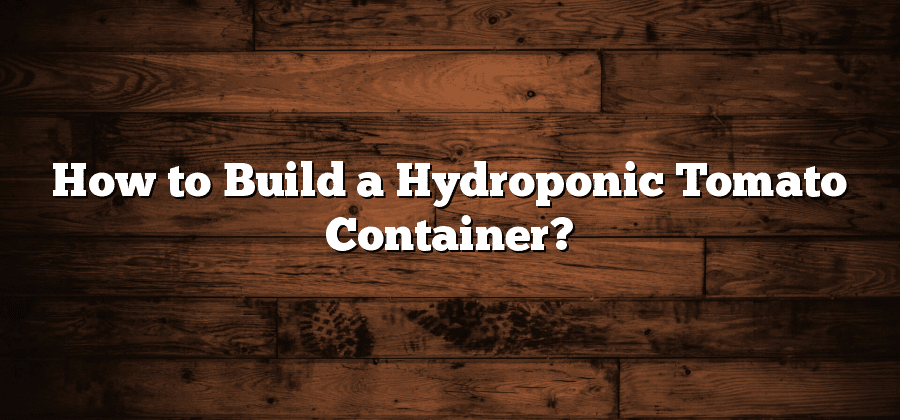Choosing the Right Container for Hydroponic Tomatoes
When it comes to choosing the right container for hydroponic tomatoes, there are a few factors to consider. First and foremost, size matters. It’s crucial to select a container that can accommodate the root system of the tomato plants as they grow. If the container is too small, the roots won’t have enough space to spread out and absorb nutrients properly, which can hinder the plant’s growth. On the other hand, if the container is too large, there is a risk of water stagnation and insufficient oxygen supply to the roots. Therefore, finding the perfect balance in terms of container size is key.
Another important aspect to consider is the material of the container. The most common options include plastic, fabric, and clay. Plastic containers are lightweight, affordable, and easily accessible. However, they may degrade over time due to exposure to sunlight and temperature fluctuations. Fabric containers, on the other hand, offer excellent aeration and drainage, allowing the roots to receive ample oxygen. They also prevent the buildup of excess salts and minerals. Lastly, clay pots are known for their durability and stability. They provide good insulation and are resistant to temperature changes. However, they are heavier and more expensive compared to other options. Ultimately, the choice of material depends on your specific needs and preferences.
Selecting the Ideal Growing Medium for Hydroponic Tomatoes
When it comes to selecting the ideal growing medium for hydroponic tomatoes, there are several factors to consider. The growing medium plays a crucial role in providing support to the plant roots, maintaining proper moisture levels, and ensuring adequate nutrient availability. One commonly used medium in hydroponics is coco coir, which is derived from the husk of coconut. Coco coir offers excellent water retention capabilities while also providing good drainage, making it ideal for tomatoes.
Another popular choice is rockwool, a synthetic substance made from heated and spun volcanic rock or slag fibers. Rockwool has good water retention properties and offers excellent aeration, creating an optimal environment for root growth. Additionally, it is pH neutral, which means it won’t interfere with the nutrient solution’s pH balance. When selecting a growing medium for hydroponic tomatoes, it is crucial to consider factors such as water retention, aeration, and pH neutrality to provide the best environment for healthy and robust tomato plants.
Understanding the Nutrient Solution for Hydroponic Tomato Cultivation
The nutrient solution is a vital component in hydroponic tomato cultivation. It serves as a replacement for soil, providing the essential nutrients needed for the plants’ growth and development. Understanding the components and formulation of the nutrient solution is crucial for achieving optimal results.
When creating a nutrient solution for hydroponic tomatoes, it is important to consider the specific needs of the plants at different growth stages. Macronutrients such as nitrogen, phosphorus, and potassium are essential for overall plant health, while secondary nutrients like calcium and magnesium play a crucial role in preventing nutrient deficiencies. Additionally, micronutrients such as iron, manganese, and zinc are required in smaller quantities but are equally important for plant growth.
To ensure the nutrient solution is properly balanced for hydroponic tomato cultivation, it is necessary to accurately measure and adjust the nutrient concentrations. This can be achieved through regular monitoring of the solution’s electrical conductivity (EC) and pH levels. Keeping the solution within the recommended range will help prevent nutrient imbalances that can negatively impact plant growth.
Setting Up the Water and Nutrient Delivery System for Hydroponic Tomatoes
When it comes to setting up the water and nutrient delivery system for hydroponic tomatoes, there are a few key considerations to keep in mind. First and foremost, it is important to choose the right type of irrigation system. There are several options available, including drip irrigation, flood and drain systems, and aeroponics. Each system has its own advantages and disadvantages, so it is important to carefully evaluate your needs and resources before making a decision.
Once you have selected the irrigation system that best suits your needs, the next step is to ensure that the water and nutrient solution is properly mixed and delivered to the plants. One option is to mix the nutrient solution manually and then feed it to the plants using the chosen irrigation system. Alternatively, you may consider using an automated dosing system that can accurately measure and deliver the appropriate amount of nutrients to the plants. Whichever method you choose, it is crucial to regularly monitor and adjust the nutrient solution to ensure that the plants are receiving the proper balance of nutrients for optimal growth.
Providing Adequate Lighting for Hydroponic Tomato Plants
Hydroponic tomato plants require proper lighting to ensure their healthy growth and optimal productivity. When it comes to choosing the right lighting system for your hydroponic setup, the most commonly used option is LED (light-emitting diode) lights. LED lights are highly efficient, energy-saving, and have a longer lifespan compared to other lighting options. Additionally, they provide a balanced light spectrum that is suitable for all stages of tomato plant growth, ranging from seed germination to fruit ripening.
When setting up the lighting system for your hydroponic tomatoes, it is crucial to consider the light intensity and duration. Tomato plants typically require around 14-16 hours of light per day during the vegetative stage, while 8-10 hours of light per day are sufficient during the flowering and fruiting stages. To ensure adequate light penetration, it is important to position the lights at an appropriate height and angle, maintaining a distance of 12-18 inches above the plant canopy. Regular monitoring of light intensity with a light meter can help you make necessary adjustments to maintain the optimal light levels for your hydroponic tomato plants.






